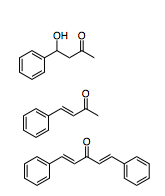pkoushik4
Harmless

Posts: 6
Registered: 11-9-2015
Member Is Offline
Mood: No Mood
|
|
Aldol product degradation
is it possible to get styrene from degradation of aldol product formed by condensation of acetone and benzaldehyde?
|
|
|
Metacelsus
International Hazard
    
Posts: 2531
Registered: 26-12-2012
Location: Boston, MA
Member Is Offline
Mood: Double, double, toil and trouble
|
|
What do you mean by "degradation"?
Also, which of these compounds did you have in mind?

|
|
|
JnPS
Hazard to Self
 
Posts: 90
Registered: 29-7-2016
Location: PA, USA
Member Is Offline
Mood: Umpolung
|
|
Couldn't you oxidize the first condensation product after the dehydration, (benzylideneacetone) to cinnamic acid and then decarboxylate it to styrene?
I wouldn't call that a degradation, or how reasonable a synth that is, but it seems possible. Isolating the single condensation product would be a
real pain though
[Edited on 15-12-2016 by JnPS]
|
|
|
Metacelsus
International Hazard
    
Posts: 2531
Registered: 26-12-2012
Location: Boston, MA
Member Is Offline
Mood: Double, double, toil and trouble
|
|
If you used a strong base such as LDA to quantitatively form the enolate, and then slowly added a stoichiometric amount of benzaldehyde, you could
isolate the single condensation product.
However, for the amateur chemist, depolymerization of polystyrene is probably a better option (see: https://www.sciencemadness.org/whisper/viewthread.php?tid=18...).
[Edited on 12-15-2016 by Metacelsus]
|
|
|
Nicodem
|
Thread Moved
15-12-2016 at 11:58 |
pkoushik4
Harmless

Posts: 6
Registered: 11-9-2015
Member Is Offline
Mood: No Mood
|
|
Hi Metacelsus, thanks for the response.
The 1st and 2nd were the structures that I had in mind. I was doing this reaction at hight temperature using a solid acid catalyst. I find that I
always get styrene as my side product in varying amounts depending on my reaction conditions
I know aldol addition product could undergo retro-aldol to give the starting compounds but I have no clue as to what kind of chemistry can lead to
this type of transformation.
I called it degradation because styrene appears to be the result of C-C bond cleavage( the other product of cleavage being acetaldehyde) between the
carbonyl carbon and the one at alpha position to it.
|
|
|
pkoushik4
Harmless

Posts: 6
Registered: 11-9-2015
Member Is Offline
Mood: No Mood
|
|
Quote: Originally posted by JnPS  | Couldn't you oxidize the first condensation product after the dehydration, (benzylideneacetone) to cinnamic acid and then decarboxylate it to styrene?
I wouldn't call that a degradation, or how reasonable a synth that is, but it seems possible. Isolating the single condensation product would be a
real pain though
[Edited on 15-12-2016 by JnPS] |
Hi JnPS, Thanks for the suggested the sequence of steps. I get Styrene as one of the side products of the aldol condensation reaction carried out
using an acid catalyst at high temperature (140 C).
I am trying to understand how I could have possibly got styrene and then possibly try to figure out a way to prevent the formation of this undesired
product.
|
|
|
pkoushik4
Harmless

Posts: 6
Registered: 11-9-2015
Member Is Offline
Mood: No Mood
|
|
I am just wondering if there could be a net hydration (adding an H,OH) which could be initiated by acid catalyzed attack of water on the ketone
carbonyl group? The other product being the acetic acid.
|
|
|
JnPS
Hazard to Self
 
Posts: 90
Registered: 29-7-2016
Location: PA, USA
Member Is Offline
Mood: Umpolung
|
|
So you're thinking benzylideneacetone + Water [H+]-> Styrene + Acetic Acid? I would think if the Aldol product got rehydrated it would turn back
into the first structure Metacelsus posted, plus if the ketone'a carbonyl was protonated for the acid catalyzed addition of water, the double bond
would allow resonance structures making both the beta carbon and the carbonyl carbon electrophilic. Isn't the dehydrated aldol product a conjugated
system, why would it spontaneously cleave like that?
What were your exact reaction conditions that yielded styrene as a by-product?
[Edited on 21-12-2016 by JnPS]
[Edited on 21-12-2016 by JnPS]
|
|
|
pkoushik4
Harmless

Posts: 6
Registered: 11-9-2015
Member Is Offline
Mood: No Mood
|
|
I don't know why, but I do observe this product. I got a similar product (1-Phenyl-1-propene) when I did the reaction with butanone. Also, I observed
that the yield towards this product increase as I increase the temperature.
The reaction temperature is 140 C. 1:3 molar ratio of benzaldehyde to Acetone and Toluene is the solvent.
[Edited on 21-12-2016 by JnPS]
[Edited on 21-12-2016 by JnPS][/rquote]
[Edited on 23-12-2016 by pkoushik4]
[Edited on 23-12-2016 by pkoushik4]
|
|
|